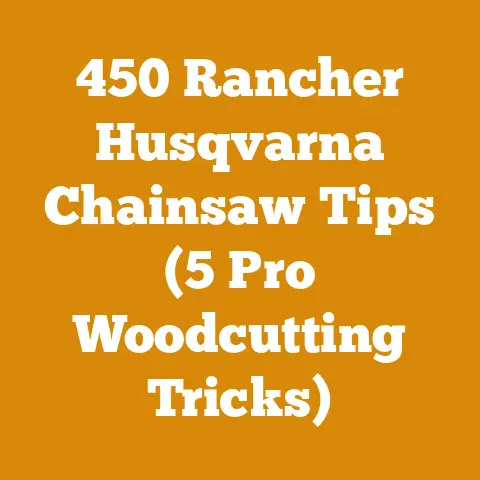450 Rancher Husqvarna Chain: Choosing the Right Bar (5 Pro Tips)
Wouldn’t it be great to always choose the perfect bar length for your Husqvarna 450 Rancher chainsaw, maximizing its performance and lifespan while tackling any woodcutting job with ease?
In this article, I’ll share five pro tips that will help you choose the right bar for your Husqvarna 450 Rancher chainsaw. We’ll delve into the factors that influence your decision, explore different bar types, and discuss how to balance performance with safety and longevity. I’ll also share some personal anecdotes and insights gleaned from my own experiences in the field.
Understanding the Husqvarna 450 Rancher
Before we dive into bar selection, let’s take a moment to appreciate the Husqvarna 450 Rancher. This saw is a workhorse, known for its reliability, power, and versatility. It’s a popular choice for homeowners, landowners, and even some professional loggers who need a dependable saw for a variety of tasks.
The 450 Rancher typically comes with a 16-inch or 18-inch bar, which is a good starting point for general use. However, depending on your needs, you might find that a different bar length or type is more suitable.
The Importance of Matching Bar to Saw
Think of your chainsaw bar as the sword for your knight (the saw). A sword too heavy or unwieldy makes the knight ineffective. Similarly, an ill-suited bar can overwork your saw’s engine, reduce cutting efficiency, and even create unsafe conditions.
Pro Tip 1: Assess Your Typical Cutting Needs
The first step in choosing the right bar is to honestly assess the types of cutting you’ll be doing most often. Are you primarily:
- Felling small to medium-sized trees?
- Bucking logs for firewood?
- Pruning branches and clearing brush?
- Doing a mix of all of the above?
The size of the wood you’ll be cutting is the most important factor in determining the appropriate bar length.
Data Point: A study by the National Timber Harvesting and Transportation Safety Foundation found that approximately 70% of chainsaw-related accidents occur during felling operations. Choosing the right bar length and using proper felling techniques can significantly reduce this risk.
Personal Experience: I remember one time when I tried to fell a large oak tree with a bar that was too short. I ended up pinching the bar in the cut and nearly got myself into a dangerous situation. It was a valuable lesson in respecting the limitations of my equipment.
Matching Bar Length to Tree Diameter
As a general guideline:
- 16-inch bar: Suitable for trees up to 12 inches in diameter.
- 18-inch bar: Suitable for trees up to 14 inches in diameter.
- 20-inch bar: Suitable for trees up to 16 inches in diameter.
These are just guidelines, of course. You can technically cut larger trees with a shorter bar, but it will require more time and effort, and it increases the risk of pinching the bar.
Cost Consideration: Using a shorter bar on a larger tree might seem like a way to save money, but it can actually increase your overall costs in the long run. You’ll spend more time on each cut, wear out your saw faster, and potentially damage your bar and chain.
Pro Tip 2: Consider the Wood Type
The type of wood you’re cutting also plays a role in bar selection. Hardwoods like oak and maple require more power to cut than softwoods like pine and fir.
Data Point: According to the U.S. Forest Service, the average density of oak is about 45 pounds per cubic foot, while the average density of pine is about 30 pounds per cubic foot. This means that oak requires about 50% more energy to cut than pine.
Personal Experience: I once tried to cut through a seasoned oak log with a dull chain on my 450 Rancher. It was like trying to cut butter with a spoon! I quickly learned the importance of using a sharp chain and a bar that was appropriate for the wood type.
Wood Density and Bar Length
If you’re primarily cutting hardwoods, you might want to consider using a slightly longer bar than you would for softwoods. This will give you more leverage and power to cut through the denser wood.
- Hardwoods: Consider using an 18-inch or 20-inch bar.
- Softwoods: A 16-inch or 18-inch bar may be sufficient.
Cost Consideration: Cutting hardwoods can put more strain on your chainsaw, which can lead to increased maintenance costs. Be sure to keep your chain sharp and properly lubricated, and consider using a high-quality bar oil.
Pro Tip 3: Understand Different Bar Types
Chainsaw bars come in a variety of types, each with its own advantages and disadvantages. The most common types include:
- Solid Bars: These are made from a single piece of steel and are the most durable type of bar. They are typically used by professional loggers and those who do a lot of heavy-duty cutting.
- Laminated Bars: These are made from multiple layers of steel that are bonded together. They are lighter and less expensive than solid bars, but they are also less durable. Laminated bars are a good choice for homeowners and those who do occasional cutting.
- Sprocket-Nose Bars: These bars have a sprocket at the tip that helps to reduce friction and wear on the chain. They are a good choice for cutting hardwoods and for plunge cutting.
Data Point: A study by Oregon Products found that sprocket-nose bars can reduce chain wear by up to 20% compared to solid bars.
Personal Experience: I’ve used both solid bars and laminated bars on my 450 Rancher. While I appreciate the durability of solid bars, I find that laminated bars are lighter and easier to handle, especially when I’m doing a lot of pruning or limbing.
Choosing the Right Bar Type for Your Needs
For most homeowners and landowners who use a Husqvarna 450 Rancher, a laminated bar is a good choice. They are affordable, lightweight, and durable enough for most cutting tasks. If you’re a professional logger or you do a lot of heavy-duty cutting, you might want to consider a solid bar.
Sprocket-nose bars are a good option if you frequently cut hardwoods or do a lot of plunge cutting.
Cost Consideration: Solid bars are typically more expensive than laminated bars. However, they will also last longer, so they may be a better investment in the long run if you do a lot of cutting.
Pro Tip 4: Consider the Power of Your Saw
The Husqvarna 450 Rancher has a 50.2cc engine, which provides plenty of power for most cutting tasks. However, if you’re using a longer bar or cutting hardwoods, you might find that the saw struggles to maintain its speed.
Data Point: A study by Stihl found that increasing the bar length by 2 inches can reduce the cutting speed by up to 10%.
Personal Experience: I once tried to use a 24-inch bar on my 450 Rancher to fell a large oak tree. The saw was able to cut through the wood, but it was slow and labored. I quickly realized that the bar was too long for the saw’s power.
Balancing Bar Length and Saw Power
It’s important to choose a bar length that is appropriate for the power of your saw. If you’re using a bar that is too long, you’ll overwork the engine and reduce the saw’s lifespan.
As a general guideline:
- 16-inch bar: Ideal for the 450 Rancher’s power.
- 18-inch bar: A good compromise between cutting capacity and power.
- 20-inch bar: Can be used for occasional cutting of larger trees, but the saw may struggle with hardwoods.
Cost Consideration: Overworking your chainsaw can lead to increased maintenance costs and a shorter lifespan. Choosing the right bar length can help to prevent this.
Pro Tip 5: Prioritize Safety and Handling
Finally, it’s important to choose a bar length that you are comfortable handling. A longer bar will give you more reach, but it will also make the saw heavier and more difficult to control.
Data Point: According to the Consumer Product Safety Commission, chainsaw-related injuries result in over 30,000 emergency room visits each year. Many of these injuries are caused by loss of control of the saw.
Personal Experience: I’ve seen firsthand how a chainsaw can quickly become dangerous in the hands of someone who is not properly trained or experienced. It’s important to take safety seriously and to choose a bar length that you can handle safely.
Choosing a Bar Length You Can Control
When choosing a bar length, consider your:
- Strength and stamina: Can you comfortably hold and maneuver the saw for extended periods?
- Experience level: Are you an experienced chainsaw user or a beginner?
- Cutting conditions: Are you cutting on flat ground or on uneven terrain?
If you’re a beginner or you’re cutting in difficult conditions, it’s best to start with a shorter bar. You can always move up to a longer bar later as you gain experience.
Cost Consideration: Investing in safety gear, such as chaps, gloves, and a helmet, is essential when using a chainsaw. These items can help to protect you from injuries and can save you money in the long run.
Chainsaw Bar Costs: A Detailed Breakdown
Now, let’s delve into the cost of chainsaw bars, considering the variables that influence pricing. I’ll break down the costs and offer tips for optimizing your spending.
Material Costs: Steel Quality and Composition
The type of steel used in a chainsaw bar significantly impacts its price. High-quality steel, like chrome-molybdenum alloy steel, offers superior durability and resistance to wear. These bars typically cost more upfront but provide a longer lifespan, reducing the need for frequent replacements.
Data Point: A solid bar made from chrome-molybdenum alloy steel can cost anywhere from $75 to $150, depending on the length and brand. A laminated bar, made from lower-grade steel, might cost between $40 and $80.
Personal Experience: I’ve found that investing in a higher-quality bar pays off in the long run. I once purchased a cheap, off-brand bar that quickly warped and became unusable. I ended up spending more money replacing it than I would have if I had just bought a quality bar in the first place.
Manufacturing Process and Brand Reputation
The manufacturing process also contributes to the cost of a chainsaw bar. Bars that are precision-engineered and undergo rigorous quality control checks tend to be more expensive. Brand reputation also plays a role, with established brands like Oregon, Stihl, and Husqvarna commanding higher prices due to their proven track record of quality and reliability.
Data Point: Oregon bars, known for their durability and performance, typically cost 15-20% more than generic brands. Husqvarna bars, specifically designed for Husqvarna chainsaws, offer optimal compatibility and performance but also come at a premium price.
Cost Optimization Tip: Consider purchasing a bar from a reputable brand, even if it costs more upfront. The increased durability and performance will likely save you money in the long run by reducing the need for replacements and repairs.
Bar Length and Type
As mentioned earlier, the length and type of bar also affect its cost. Longer bars require more material and are more complex to manufacture, resulting in higher prices. Solid bars are typically more expensive than laminated bars due to their single-piece construction and increased durability.
Data Point: A 20-inch solid bar can cost $100-$200, while a 16-inch laminated bar might cost $40-$80.
Regional Price Variations
The cost of chainsaw bars can also vary depending on your location. Prices may be higher in areas with limited competition or high demand. Shipping costs can also add to the overall price, especially if you’re purchasing from an online retailer.
Personal Experience: I’ve noticed that chainsaw bars tend to be more expensive in rural areas where there are fewer hardware stores and outdoor equipment suppliers. I often shop online to find better deals, but I always factor in shipping costs before making a purchase.
Cost Optimization Tip: Compare prices from multiple retailers before making a purchase. Consider buying online to take advantage of competitive pricing, but be sure to factor in shipping costs and return policies.
Calculating the Total Cost of Bar Ownership
To accurately assess the cost of a chainsaw bar, you need to consider not only the initial purchase price but also the cost of maintenance and replacement.
Formula:
- Total Cost of Ownership = Purchase Price + (Maintenance Costs x Lifespan) + Replacement Costs
Maintenance costs include the cost of bar oil, chain sharpening, and occasional repairs. Replacement costs depend on the lifespan of the bar and the frequency of use.
Example:
Let’s say you purchase a laminated bar for $60. You estimate that you’ll spend $10 per year on bar oil and chain sharpening, and the bar will last for 5 years. The total cost of ownership would be:
- $60 + ($10 x 5) + $0 = $110
If you purchase a solid bar for $120, but it lasts for 10 years and requires the same amount of maintenance, the total cost of ownership would be:
- $120 + ($10 x 10) + $0 = $220
While the solid bar has a higher initial cost, it may be a better value in the long run due to its longer lifespan.
Budgeting for Chainsaw Bar Purchases
Creating a budget for chainsaw bar purchases can help you make informed decisions and avoid overspending.
Setting a Realistic Budget
Start by assessing your cutting needs and determining the type and length of bar that is most appropriate for your tasks. Research prices from multiple retailers and set a realistic budget based on your findings.
Personal Experience: I like to create a spreadsheet to track my chainsaw expenses, including the cost of bars, chains, oil, and maintenance. This helps me to stay on budget and make informed decisions about future purchases.
Prioritizing Quality over Price
While it’s tempting to save money by purchasing a cheap bar, it’s important to prioritize quality over price. A higher-quality bar will last longer, perform better, and reduce the risk of accidents.
Cost Optimization Tip: Consider buying a used bar from a reputable source. You can often find high-quality used bars at a fraction of the price of new ones. Just be sure to inspect the bar carefully for signs of damage or wear before making a purchase.
Planning for Replacement Costs
Chainsaw bars eventually wear out and need to be replaced. Factor replacement costs into your budget to avoid unexpected expenses.
Rule of Thumb: A laminated bar typically lasts for 2-5 years, while a solid bar can last for 5-10 years, depending on the frequency of use and the type of wood you’re cutting.
Leveraging Discounts and Promotions
Take advantage of discounts and promotions to save money on chainsaw bar purchases. Many retailers offer seasonal sales, coupon codes, and loyalty programs that can help you reduce your costs.
Cost Optimization Tip: Sign up for email newsletters from your favorite retailers to receive notifications about upcoming sales and promotions. Follow them on social media to stay informed about special deals.
Additional Cost Factors to Consider
Beyond the direct cost of the bar, several other factors can impact your overall wood processing expenses.
Chain Costs
The chainsaw chain is a consumable item that needs to be replaced regularly. The cost of chains can vary depending on the type, length, and quality.
Data Point: A high-quality chainsaw chain can cost anywhere from $20 to $50, depending on the size and type.
Cost Optimization Tip: Keep your chain sharp to prolong its lifespan and improve cutting efficiency. A dull chain can put more strain on your chainsaw and increase the risk of kickback.
Bar Oil Costs
Bar oil is essential for lubricating the chain and bar, reducing friction and wear. The cost of bar oil can vary depending on the brand and type.
Data Point: A gallon of high-quality bar oil can cost between $10 and $20.
Cost Optimization Tip: Use a high-quality bar oil that is specifically designed for chainsaws. This will help to protect your bar and chain and prolong their lifespan.
Labor Costs
If you’re hiring someone to cut wood for you, labor costs can be a significant expense. The hourly rate for a professional logger or tree service worker can vary depending on your location and the complexity of the job.
Data Point: The average hourly rate for a professional logger in the United States is between $20 and $40.
Cost Optimization Tip: Consider doing the work yourself if you’re comfortable using a chainsaw and have the necessary safety gear. This can save you a significant amount of money on labor costs.
Fuel Costs
Chainsaws require fuel to operate. The cost of fuel can vary depending on the type of fuel and your location.
Data Point: The average price of gasoline in the United States is currently around $3.50 per gallon.
Cost Optimization Tip: Use a fuel-efficient chainsaw and avoid idling the engine for extended periods. This will help to reduce your fuel consumption and save you money.
Maintenance Costs
Chainsaws require regular maintenance to keep them running smoothly. Maintenance costs can include the cost of spark plugs, air filters, and other replacement parts.
Data Point: The average cost of a chainsaw tune-up is between $50 and $100.
Cost Optimization Tip: Perform regular maintenance on your chainsaw to prevent costly repairs. Keep the air filter clean, change the spark plug regularly, and lubricate the moving parts.
Case Studies: Real-World Cost Comparisons
To illustrate the impact of bar selection on overall costs, let’s examine two case studies:
Case Study 1: Firewood Preparation
A homeowner uses a Husqvarna 450 Rancher to prepare firewood for their home. They primarily cut softwoods and use a 16-inch laminated bar. They spend $50 per year on bar oil and chain sharpening, and they replace the bar every 3 years.
- Bar Cost: $60
- Maintenance Costs (3 years): $150
- Replacement Cost (3 years): $60
- Total Cost (3 years): $270
Case Study 2: Small-Scale Logging
A small-scale logger uses a Husqvarna 450 Rancher to fell trees and buck logs. They primarily cut hardwoods and use an 18-inch solid bar. They spend $100 per year on bar oil and chain sharpening, and they replace the bar every 5 years.
- Bar Cost: $120
- Maintenance Costs (5 years): $500
- Replacement Cost (5 years): $120
- Total Cost (5 years): $740
While the logger’s initial bar cost is higher, they benefit from the increased durability and performance of the solid bar, which lasts longer and reduces the need for frequent replacements.
Actionable Takeaways and Next Steps
Choosing the right bar for your Husqvarna 450 Rancher is a crucial decision that can impact its performance, safety, and longevity. By considering your cutting needs, wood type, bar type, saw power, and handling ability, you can select the perfect bar for your tasks.
Here are some actionable takeaways and next steps:
- Assess your cutting needs: Determine the types of cutting you’ll be doing most often and the size of the wood you’ll be cutting.
- Consider the wood type: Choose a bar length that is appropriate for the density of the wood you’ll be cutting.
- Understand different bar types: Select a bar type that is durable enough for your cutting tasks.
- Balance bar length and saw power: Choose a bar length that is appropriate for the power of your saw.
- Prioritize safety and handling: Select a bar length that you are comfortable handling safely.
- Set a realistic budget: Research prices from multiple retailers and set a realistic budget based on your findings.
- Prioritize quality over price: Invest in a higher-quality bar that will last longer and perform better.
- Plan for replacement costs: Factor replacement costs into your budget to avoid unexpected expenses.
- Leverage discounts and promotions: Take advantage of discounts and promotions to save money on chainsaw bar purchases.
- Invest in safety gear: Always wear appropriate safety gear when using a chainsaw, including chaps, gloves, and a helmet.
By following these tips, you can choose the right bar for your Husqvarna 450 Rancher and enjoy years of safe and efficient cutting. Remember, a well-chosen bar is an investment in your saw, your safety, and your overall wood processing success. Now, go forth and conquer those woodcutting projects with confidence!






